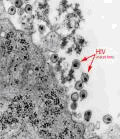 |
The most commonly accepted theory is that HIV, first identified
in 1983, came from a simian (monkey) virus that spread to
humans in Africa during the 1930's and 1940's. The transmission
of HIV has been driven by multiple changes in migration, housing,
travel, sexual practices, drug use, war, and economics that
have affected both Africa and the entire world since 1940.
AIDS was first recognized in the United States in 1981; the
US Centers for Disease Control and Prevention (CDC) issued
a warning about the symptoms that were caused by what we now
know to be HIV. In the Commonwealth of Kentucky, the first
reported case of AIDS was in 1982. Since then, the number
of AIDS cases has continued to increase both in the U.S. and
other countries.
People who are infected with HIV come from all races, all
countries, sexual orientations, genders, and income levels.
Globally, most of the people who are infected with HIV have
not been tested, and are unaware that they are living with
the virus.
The Human Immunodeficiency Virus (HIV) is the virus
that attacks the immune system, damaging the body's ability
to fight the organisms that cause infections and diseases.
It is the virus that leads to a diagnosis of AIDS. But HIV
and AIDS are not the same. Everyone who has AIDS has been
infected with HIV; but everyone with HIV infection does not
have AIDS.
 |
This highly magnified transmission electron micrographic
(TEM) image
revealed the presence of mature forms of the human immunodeficiency
virus (HIV) in a tissue sample under investigation.
Courtesy of US Public Health Image Library.
|
HIV has divided into two primary strains:
HIV-1 and HIV-2. HIV-1 is found throughout the world. HIV-2
is found primarily in West Africa, where the virus may have
been in circulation since the 1960s - 1970s. Both HIV-1 and
HIV-2 have several subtypes. It is virtually certain that
more undiscovered subtypes are in existence now. It is also
probable that more HIV subtypes will evolve in the future.
Acquired ImmunoDeficiency (sometimes Immune
Deficiency) Syndrome (AIDS) is a complex of symptoms and
diseases caused by the HIV virus as it impacts the immune
system. It is an acquired disease. As HIV damages the immune
system, infected persons become vulnerable to opportunistic
organisms. These opportunistic infections generally do not
pose a threat to persons with healthy functioning immune systems.
The diagnosis of AIDS requires a positive HIV antibody test
or evidence of HIV infection and the appearance of some very
specific conditions/diseases.
AIDS Indicator Conditions (Adults)
A positive HIV test plus one or more of the
following:
- Candidiasis, of esophagus, trachea, bronchi or lungs.
- Cervical cancer, invasive.
- Coccidioidomycosis, extrapulmonary.
- Cryptococcosis, extrapulmonary.
- Cryptosporidiosis with diarrhea greater than one month.
- Cytomegalovirus of any organ other than liver, spleen,
or lymph nodes.
- Herpes simplex with mucocutaneous ulcer lasting longer
than one month or bronchitis, pneumonitis, esopagitis.
- Histoplasmosis, extrapulmonary.
- HIV-associated dementia: disabling cognitive and/or motor
dysfunction interfering with activities of daily living.
- HIV-associated wasting: involuntary weight loss >10%
of baseline plus chronic diarrhea (2 loose stools/day for
30 days) or chronic weakness and documented enigmatic fever
30 days.
- Kaposi's sarcoma.
- Lymphoma of brain.
- Lymphoma, non-Hodgkins of B-cell or unknown immunologic
phenotype and histology showing small, noncleaved lymphoma
or immunoblastic sarcoma.
- Mycobacterium avium complex or M. kansasii, disseminated.
- Tuberculosis.
- Nocardiosis.
- Pneumocystis carinii pnuemonia.
- Pneumonia, recurrent-bacterial (2 episodes in 12 months).
- Progressive multifocal leukoencephalopathy.
- Salmonella septicemia (non-typhoid), recurrent.
- Strongyloidiasis, extraintestinal.
- Toxoplasmosis of internal organs.
When HIV enters the bloodstream, the virus seeks a particular
lymphocyte, the CD4 cell (also called the T4 cell or
T-Helper lymphocyte), which functions to "orchestrate" the
immune system in the event of attack from pathogens. Upon
contact with HIV the T-cell signals the production of antibodies.
Particularly frustrating about HIV is that the antibodies
produced to fight the virus are not able to do so, since HIV
captures the cells that signal antibodies to be produced.
The result is an eventual decline of the immune system.
The 1993 Revised AIDS Surveillance
Case Definition
In 1987, the CDC defined AIDS using a positive HIV antibody
test plus a list of conditions that indicated a deficient
immune system. The original case definition of HIV infection
was based on the clinical symptoms seen in men. In 1993, the
CDC revised the classification system for HIV infection and
expanded the case definition for AIDS to include more conditions
and a variety of CD4-cell counts; it included invasive cervical
cancer, obviously a condition found only in women. The revised
definition meant that more people were considered to have
AIDS. That year there was a "jump" in the number of people
with AIDS which reflected the change in classification system.
An AIDS diagnosis is only made by a licensed healthcare provider,
based on a confirmed HIV test result, the presence of certain
defining physical conditions, and the person's CD4-cell count.
HIV has a wide spectrum of clinical presentations in children.
The CDC developed a revised pediatric HIV classification system
in 1994, to clarify HIV-infected pediatric patients into categories
based on their immune system, CD4 cells, and clinical category.
Pediatric classification of AIDS is different than the classification
for adults.
The 1993 AIDS Surveillance Case Definition for Adolescents
and Adults, which is the most current definition, is comprised
of a 3 x 3 staging system. In this definition, any person
who is HIV-infected and has either an AIDS indicator condition
or a CD4+, the T-cell count, less than 200 cells/mm3, or less
than 14%, is considered to have AIDS.
Continue on to HIV/AIDS
Basic Medical and Epidemiological Information, Con't.
|
 |